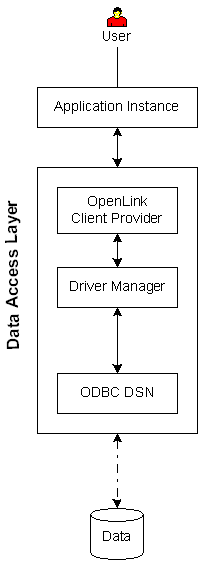OLE DB Data Access Providers - Logical Diagrams
This section provides logical diagrams forSingle-Tier (Lite Edition) Drivers
Single-Tier (Lite Edition) Drivers
OLE DB Data Access Providers | Executive Summary: A clientside-only solution that provides enterprise grade data access with minimal configuration.
Architectural Components: Application Instance(s), Functional Capabilities: OLE DB data access to SQL data stores via ODBC data sources. Hardware/OS Dependencies: Other Dependencies: Performance Levels: High. Implementation Variances: 1) All architectural components may reside on the same machine, 2) Data store may reside on a remote machine. Security Features: Constraints & Limitations: Solution applies only to data stores that are accessible via ODBC DSNs. |
 Users are humans or non-human agents that leverage applications to obtain or manipulate SQL data held in data repositories.
Users are identified by the hostname or IP address of the machine which hosts their target application(s).
Users are humans or non-human agents that leverage applications to obtain or manipulate SQL data held in data repositories.
Users are identified by the hostname or IP address of the machine which hosts their target application(s).
 The application instance refers to individual instances of applications that users exploit in the target architecture.
Each instance of the application(s) is tasked with returning SQL data to users in a manner that is meaningful to them.
The application instance refers to individual instances of applications that users exploit in the target architecture.
Each instance of the application(s) is tasked with returning SQL data to users in a manner that is meaningful to them.
 The
The  The driver manager is a generic utility that loads drivers when requested to do so by client applications.
The driver manager is a generic utility that loads drivers when requested to do so by client applications.
 The
The  Database native client refers to third-party database client communications software that facilitates connectivity to the target data store.
This software speaks the native protocol of that data store.
Database native client refers to third-party database client communications software that facilitates connectivity to the target data store.
This software speaks the native protocol of that data store.
 ODBC DSN or JDBC URL refers to ODBC data sources or JDBC connection URLs that pre-exist on the client system.
These DSNs or JDBC URLS often use 3rd-party data access products, but they may use
ODBC DSN or JDBC URL refers to ODBC data sources or JDBC connection URLs that pre-exist on the client system.
These DSNs or JDBC URLS often use 3rd-party data access products, but they may use  The
The  Data refers to SQL data that is contained in the target data store.
Data refers to SQL data that is contained in the target data store.
 Local IPC communications between architectural components.
Local IPC communications can only occur when architectural components are hosted on the same, physical machine.
Local IPC communications between architectural components.
Local IPC communications can only occur when architectural components are hosted on the same, physical machine.
 TCP/IP-based communications between architectural components.
TCP/IP-based communications can occur across machine boundaries.
TCP/IP-based communications between architectural components.
TCP/IP-based communications can occur across machine boundaries.